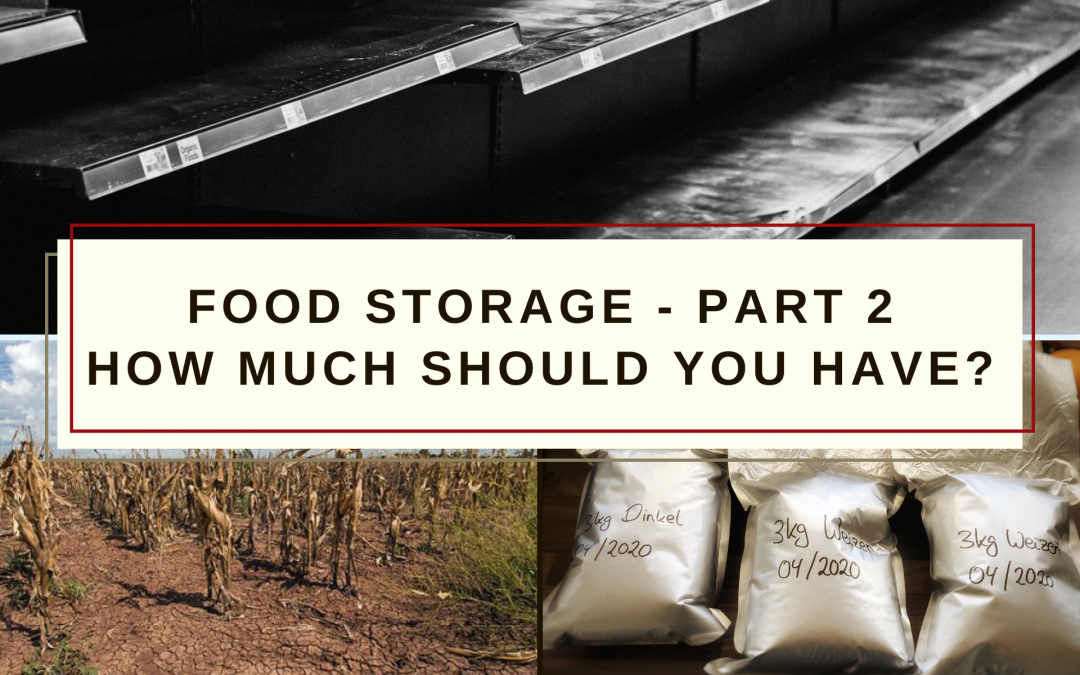There is a simple answer to this question:
As much as you can!
I get it, this answer is not really satisfying, so let’s take a closer look at this topic.
How much does a person need per day?
The average adult needs approximately 2,200 kcal per day.
That is when the person is sitting around all day, doing absolutely nothing.
In a “shit hit the fan” scenario you won’t be sitting around idly. You will be constantly stressed and full of adrenaline, trying to sort stuff out, chopping firewood, working the fields, foraging or keeping a watch for potential threats. This will easily push your calorie consumption to 3,000-4,000 kcal per day.
I personally plan with 3,000 kcal per day which is what I usually burn during a normal day (working in front of a desk, some chores and one workout).
How much is that in food?
Probably more than you think.
3,000 kcal equals:
- 1kg / 2.2lbs of rice
- 5kg / 11lbs of potatoes
- 20 eggs
- 3 grilled chickens
Hopefully, you now get an idea why a few packs of instant noodles won’t do it.
When buying food, you can easily calculate how much you need by looking at the kcal on the food labels (kind of obvious, I know).
What’s the bare minimum?
Are you new to prepping and simply want to prepare for short-term disasters and emergencies?
In this case, 2 weeks’ worth of food is the minimum you should have. This is actually the bare minimum everyone – prepper or not – should have at home.
It’s just common sense! 10-14 days is also the amount most governments officially recommend.
Preparing for Climate Change disasters
When we are talking about climate change and its catastrophic consequences, we are not talking about a short-term scenario. When crops fail in several of the world’s food baskets and people have to flee their home country due to lethal wet-bulb temperatures, the world will never go back to normal.

This is why you need to start producing your own food.
The thing is:
If climatic conditions become so bad that traditional agriculture fails, your crops will also be in trouble!
This is why we are working on diversifying our food sources and making them more resilient.
Nonetheless, you will face times when you or your community won’t be able to harvest enough calories to feed every mouth.
This is when your long-term food storage will save your life!
What and how should you store?
We will delve deeper into the individual methods of storing and conserving food in upcoming posts.
Until then, there are two easy ways you can start with right now.
1. Rotating the foods that you eat anyway
Just buy some extra of the foods you eat on a daily basis. Two packs of whatever instead of one, every time you go shopping. Consume the oldest ones and store the new ones in the back of the shelf. Adapt the stored amount to the expiration date and the amount you consume. This way you can make sure you never let food go bad.
Foods you can easily do this with include:
- Rice
- Pasta
- Flour
- Beans
- Eggs
- Dairy Products
- Oils
- …
Rotating foods like this should be a habit for everyone. It doesn’t cost anything extra in the long-run but can prevent panic-buying or dependence on emergency services in any disaster situation.
2. Storing non-perishable foods long-term

This will be your long-term storage. This will be the stocks you rely upon when things get really bad. The best way to store food long-term is by vacuum sealing it in mylar bags. All you really need for this is mylar bags, plenty of oxygen absorbers, a hot iron and a plastic bucket to prevent rodents from getting to the bags. This works with most raw, dry foods you can find. Best-suited are:
- Whole grains (wheat, rye, oats, corn, etc.)
- White rice
- Beans
- Pasta
Stored like this these foods will easily last 10-20 years.
Really, the only limits to how much food you should store this way are the money you are willing to spend and the space to have for storage.
Food is still incredibly cheap right now. This will most likely change very soon though, so don’t wait too long.
Watch out for our upcoming posts with detailed step-by-step guides to store food!


Trackbacks/Pingbacks